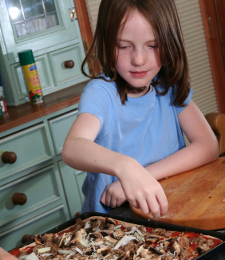(Note: This is the third post in a series)
The years between the ages of six and twelve are about learning to share and compromise, lessons that your children will be absorbing in the classroom, on the playground and around the dinner table. Just as kids are learning that they cannot always get their way when choosing a game to play at recess, they will learn at home that not everyone gets their choice of dinner every night. You may find that your kids want to figure out ways to make meal choice “fair,” with each one getting to choose one meal a week, or each child getting the chance to veto a proposed meal. Children will want airtime around the dinner table to be equitably distributed, although some children will still need help telling a story about their day.
 This is also a time when children are more aware of the world around them. They may start to ask for foods they have seen advertised on TV or for foods they have eaten at their friends’ houses. At this time, your family’s identity as distinct and different from others may emerge, and what you serve at dinner may be one of the defining features. Some of my sons’ friends liked to come over for spicy sesame noodles or apple-and-cheese crepes, while my sons coveted the brisket at one friend’s house and moaned that I wouldn’t serve chicken fingers like another mother.
This is also a time when children are more aware of the world around them. They may start to ask for foods they have seen advertised on TV or for foods they have eaten at their friends’ houses. At this time, your family’s identity as distinct and different from others may emerge, and what you serve at dinner may be one of the defining features. Some of my sons’ friends liked to come over for spicy sesame noodles or apple-and-cheese crepes, while my sons coveted the brisket at one friend’s house and moaned that I wouldn’t serve chicken fingers like another mother.
As they progress through elementary school, girls and boys are becoming competent to read and follow recipes. They can be expected to help with setting the table, with clearing their places and with helping to clean up. Their involvement in the dinner ritual will contribute to their interest in it. At this stage, my kids began to want to be in charge of dinner, an impulse I encouraged. One of my sons’ favorite games was to create a restaurant with tablecloths, menus that they printed and a pad to take orders. They would send me out to do their shopping and then would let me hang around as a sous-chef while they created their own masterpieces.
This is a time to harness the elementary school-aged child’s wish to be more competent and to play by the rules. Here are few developmentally informed guidelines to keep in mind:
— Since school-aged kids like structure and order, your children may feel comforted by a predictable schedule of meals. For example, in my sister’s family, Monday night was pasta with pesto and chicken sausage. Tuesday was roast chicken, Wednesday cheeseburgers, and so on. A routine like this cuts down on conflict if your children can agree on five or six meals. Often, the routine needs to be tweaked or altered to prevent boredom or to accommodate new tastes or the demands of a new season.
 — At this stage of development, kids are very interested in foods they have seen advertised on TV or eaten in restaurants. It can be fun to re-create one of these meals at home, making a healthier version. For example, most supermarkets offer ready-made pizza dough. It is quite simple to roll this out on a floured surface, and then place on an oiled cookie sheet. Then, just spread tomato sauce from a jar, and customize the pizza with mushrooms, peppers, onions, sliced pepperoni, eggplant or anything else that appeals to your kids. Sprinkle Parmesan or mozzarella cheese (or both) on top, and bake for about 10 minutes in a 450-degree oven. Other restaurant-type meals that translate easily into home kitchens are tacos and crepes.
— At this stage of development, kids are very interested in foods they have seen advertised on TV or eaten in restaurants. It can be fun to re-create one of these meals at home, making a healthier version. For example, most supermarkets offer ready-made pizza dough. It is quite simple to roll this out on a floured surface, and then place on an oiled cookie sheet. Then, just spread tomato sauce from a jar, and customize the pizza with mushrooms, peppers, onions, sliced pepperoni, eggplant or anything else that appeals to your kids. Sprinkle Parmesan or mozzarella cheese (or both) on top, and bake for about 10 minutes in a 450-degree oven. Other restaurant-type meals that translate easily into home kitchens are tacos and crepes.
— When children are school-aged, it becomes harder to protect them from the onslaught of marketing aimed at enticing kids to want fatty foods, soft drinks and other unhealthy foods. Invite your children to practice resistance to destructive media messages. Ask children why they think TV ads are advertising “lunchables” (processed food in a plastic container) rather than carrots and celery. Or, ask them what they think would happen if junk food carried a high tax the way cigarettes do. Or, what it would be like if their school refused to sell unhealthy food in the cafeteria.
In some ways this is the easiest time to engage kids in eating dinner with their parents, and indeed, more than half of 9-year-olds eat dinner with their families every day. By the time kids are 14 years old, only a third will be sitting down for a nightly dinner. So, live it up now, and perhaps the fun routines you set with your elementary school-aged kids will build momentum for the teenage years.

 Anne Fishel is an Associate Clinical Professor of Psychology at the Harvard Medical School and the Director of the Family and Couples Therapy Program at Massachusetts General Hospital. She has lectured and written about the benefits of family meals.
Anne Fishel is an Associate Clinical Professor of Psychology at the Harvard Medical School and the Director of the Family and Couples Therapy Program at Massachusetts General Hospital. She has lectured and written about the benefits of family meals.